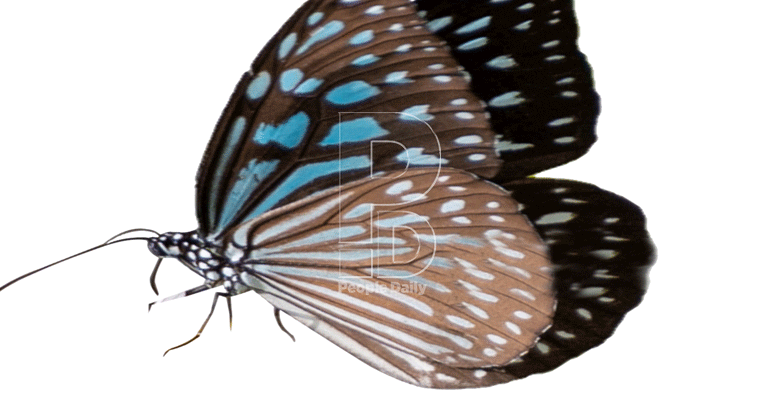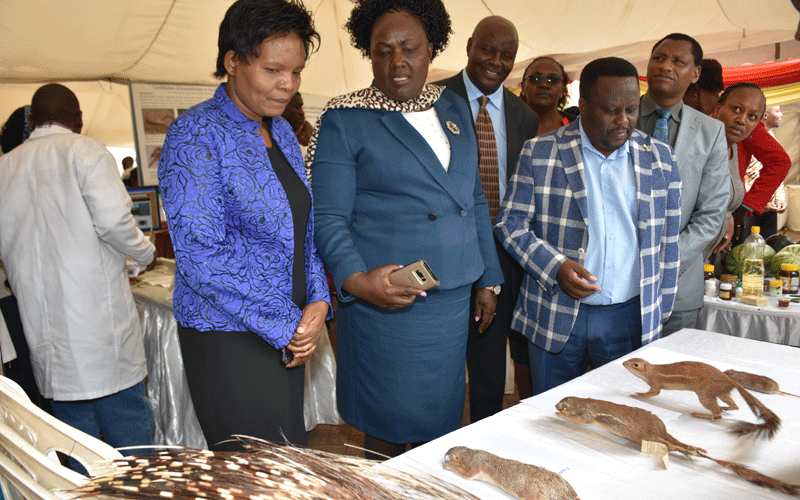Researchers in push to protect butterfly species

Reuben Mwambingu @reubenmwambingu
On a chilly morning, Oliver Genga strolls on the fringes of the mist-clad Ngangao Forest in Wundanyi town in Taita Taveta county, holding a sweep net.
He painstakingly tracks a butterfly as it darts and glides infinitely at the forest edge, before swinging the net to trap it.
“This is Papilio Desmondi Teita, a butterfly species endemic to Taita Hills Forest,” Genga says as he rushes back to a nearby makeshift laboratory.
Genga is pursuing a master’s degree in Science at the Kenyatta University. He is on a mission to study species of unique butterflies found in Taita Hills.
The study is part of the National Museums of Kenya (NMK) project titled “assessment of Lepidoptera pollinator species diversity data in East Africa,” focusing on diversity of butterflies and moths as key providers of ecosystem pollination services.
Study has involved researchers from universities in Kenya and outside the country.
Project, which started in 2017, is funded by JRS Biodiversity Foundation, an independent foundation based in Seattle, Washington, which awarded NMK Sh28.5 million to undertake the study in December 2016.
“We want to establish the relationship between butterflies and the host plant. We also want to identify how the host plant affects butterfly growth and which plants are more preferred by the butterflies,” Genga explains.
The findings are intended to help the community understand the need to protect the host plants and subsequently the butterflies.
Properly conserved
Dense Ngangao Forest is a biodiversity hotspot hosting a variety of incredible endemics and unique flora and fauna.
It is in this forest where scientists have recorded three endemic species of butterfly only found within the Taita Hills and not anywhere else in the word.
A recently published NMK field guide titled Fluttering Beauty with benefits, the butterflies of Taita Hills; identifies the three endemic species as the Taita Glider (Cymothoe Teita), Desmond’s Green Banded swallowtail or (Papilio desmondi teita) and Forest King Charaxes or (Charaxes xiphares desmondi).
Dr Esther Kioko, a Principal Research Scientist and Head of Zoology at NMK reckons the said endemic species were only recorded in the fragments of the Taita Hills and not anywhere else, signifying the species could be on the brink of extinction if not properly conserved.
Kioko says butterflies and moths characterised by their scaly wings provide pollination services, playing a vital role to the ecosystem. “Butterflies play a key role in the conservation of forests. Caterpillars and butterflies rely on specific host plants to feed and also lay eggs.
Therefore it becomes very important that farmers engage in conservation of these plants to keep these pollinators alive for good productivity,” Kioko says, noting the project focuses on butterfly species as key pollinators.
Study started in Ngangao before moving to Chawia and Kasighau forests, all which are part of Taita Hills.
Duncan Mwinzi, another researcher from University of Nairobi’s faculty of Agriculture, established that intensified farming activities in villages surrounding Ngangao are a threat to the existence of butterflies and moths in the area.
His study titled “Diversity and abundance of butterfly species and farmers pesticide use practices in forest edge and farmlands of Taita Hills,” established there was more diversity at the forest end compared to farmlands.
In the study conducted between December 2017 and May 2018, butterfly sampling was done in Ngangao Forest edge and the adjoining farmlands.
Significantly higher
“Two methods of sampling were employed, Line transect counts and use of butterfly-baited traps. 144 species and 62 genera were recorded during the period of study on the forest edge and the adjoining farmlands.
The forest edge recorded 133 butterfly species significantly higher than the farmlands which recorded 113 butterfly species,” the study states in part.
A total of 17,438 butterflies were recorded over the sampling period whereby the forest edge recorded a 60.1 per cent in butterfly abundance while the farmland recorded 39.9 per cent.
In his study, Mwinzi arrived at the 60.1 per cent and 39.9 per cent abundance from the total butterfly observations from the forest edge, which recorded 10,477 butterfly individuals while the farmlands recorded 6,961 giving a total of 17,438 records.
During the same period, a survey conducted within 10 farming villages adjacent to Ngangao to determine pesticide use and awareness on insect pollinators confirmed there is high use of the chemical by farmers.
The research discovered that 29 chemical pesticide active ingredients belonging to 14 chemical groups were used against different pests and diseases.
According to Mwinzi, this high use of pesticides could be the reason for the reduced diversity and abundance of butterfly species within the farms, and recommended awareness creation for local farmers on environmentally friendly chemicals.
So far a total of 211 butterfly species have been recorded in Taita Hills.
International Centre of Insect Physiology and Ecology (Icipe) records indicate that in parts of the world, especially in the northern hemisphere, managed and wild bees are disappearing and populations declining. There is, however, limited data for the African continent.
Icipe warns bees’ health and colony integrity might be impaired by several types of environmental threats, especially pests and pathogens, intensification of agriculture resulting in high exposure to pesticides and habitat degradation.
Similarly for the 211 butterfly species recorded in the Taita hills one of them, Papilio desmondi teita is categorised as endangered and listed in the International Union for Conservation of Nature (IUCN) red list of swallowtail butterflies of the world.
As a result, researchers now recommend taking care of forests as a number one priority towards salvaging the variety of pollinators, to bolster food security and livelihoods of millions of rural resource-poor farmers.
“Once forests are encroached the effects are two fold because homes to insects are destroyed, rivers, which they rely on for water, dry up, and global temperatures increase.
The insects will automatically migrate. This will mean pollination of plants decreases and food security will be compromised,” Dr Kioko reckons.
To inspire the community, the researchers are sharing the knowledge about the three species endemic to Taita Hills to help the community understand how matchless the region is from the rest of the world, and understand the value of the unique natural heritage.
In the project, the scientists have mentored several youth groups and a local primary school on how to generate income through butterfly farming.
“Once the locals understand the importance of this conservancy and what it harbours, they will be happy to conserve,” Kioko says.
“We are also training locals on butterfly farming where we encourage them to plant the host plants to attract the insects in the farmlands.
The sale of butterfly pupae has contributed to the livelihoods of many communities,” he adds.
Local community
Amos Mwamburi, a member of Chawia youth group, which has benefitted from mentorship under the project, says with the knowledge they gained, the group now has a butterfly cage from which they generate income.
“In future we intend to build a bigger flight cage for exhibitions as part of ecotourism,” says Mwamburi.
His colleague, Leonard Mwadime, hails the project for enriching their networking and further opening up a spectrum of opportunities in entrepreneurship.
The group is currently sensitising the local community to plant more trees, predominantly the host plants, with the motive of preserving the heritage.
“We have done a lot of forest restoration. So far we have planted over 5,000 seedlings of different host plants such as the Clausena anisata and Todallia asiatica and we have seen the benefits,” Mwadime says.
Group, have, however, reported setbacks after butterfly markets in Europe were closed in the initial stages of the Covid-19 pandemic.
John Maghanga, secretary of Dawida Biodiversity Conservation Group, who is also the Chairman of Maghimbinyi Primary School has started nurturing young learners to practice butterfly farming.
“We want to take it further to make it an income generating project for the school in the near future.
At Maghimbinyi Primary we have planted over 200 host plants and now learners have started interacting with butterflies in the school compound,” he says.








